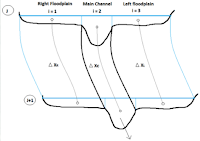Preview of the new Finite-Volume Approach for 1D Reaches
Written by Chris Goodell | January 11, 2019
One of the most anticipated new features soon to come in the next major version of HEC-RAS (Version 5.1) is the option of running unsteady 1D reaches with a finite volume solution scheme. This will be a fantastic addition to HEC-RAS. Gary Brunner recently gave me a brief overview of the new finite volume feature we can expect. But before you ask, there is no set release date for Version 5.1 yet. But I’m hoping we’ll see it within the next year or two.
1D Finite Volume Solution Algorithm
By Gary W. Brunner, P.E., D.WRE
Senior Technical Hydraulic Engineer
Hydrologic Engineering Center
A brand new solution algorithm has been developed for 1D modeling. A Finite-Volume solution approach, similar to what was added for 2D modeling will be available for 1D modeling in HEC-RAS version 5.1.
The current 1D Finite Difference solution scheme has the following deficiencies:
- Cannot handle starting or going dry in a cross section
- Low flow model stability issues with irregular cross section data
- Extremely rapidly rising hydrographs can be difficult to get stable
- Mixed flow regime (i.e. flow transitions) approach is approximate
- Stream junctions do not transfer momentum
The new 1D Finite Volume approach has the following positive attributes:

- Can start with cross sections completely dry, or they can go dry during a simulation (wetting/drying)
- Very stable for low flow modeling
- Can handle extremely rapidly rising hydrographs without going unstable
- Handles subcritical to supercritical flow, and hydraulic jumps better.
- Junction analysis is performed as a single 2D cell when connecting 1D reaches (continuity and momentum is conserved through the junction).
Additionally, the new 1D Finite Volume approached is solved in the same matrix as the 2D equations. Solving in the same matrix allows for faster 1D/2D model solutions and more accurate flow transfers between 1D and 2D elements. The equations are solved together and all hydraulic connections are updated together on an iteration by iteration approach, rather than separately, as in previous versions of HEC-RAS.

Comments
Mark
on January 16, 2019Hi Chris. 5.1 really does sound like a giant step forward. What kills me though is your comment on 1 to 2 years! I had been building up an expectation of around July this year.
Unknown
on January 16, 2019I'm excited to see this addition! I'm hoping the junction method will solve some of the model flexibility issues I'm trying to work around using a storage area junction approach. In particular if this junction method will allow for the mainstem reach to remain continuous and that you will be able to connect and disconnect tributary reaches without having to rename reaches and update flow files when new junctions are added?
Chris Goodell
on January 16, 2019It's possible Mark. HEC does not give out anticipated release dates anymore probably because it is so hard to forecast how long testing takes. My 1 to 2 years estimate is purely a guess on my part. Let's cross our fingers that I'm wrong and it comes out even earlier!
Chris Goodell
on January 16, 2019I don't think that's the direction they're going with this, but I could be wrong…
Reuben Cozmyer
on January 18, 2019Seriously, do they have George R R Martin on their development team?
Unknown
on January 24, 2019Thanks for sharing this Chris. Really looking forward to this update as I reflect back on the hours spent incrementally reducing flows while trying to maintain some semblance of stability.
Unknown
on April 4, 2019Very interesting to me. By the way, can i know the free online course of HEC-RAS for flood modeling? thanks in advance.
Antonio
on July 7, 2021Hi guys, with this new algorithm, may i ask how to handle the xs near a bridge o inline? because i’ve always put them very close to the structure but new, with the new method, this close positioning it may introduce a volume loss, if i’ve understand correctly
Chris Goodell
on July 7, 2021Should still be good to put them close, since at structures, RAS switches to the empirical structure equations instead of using the finite difference or finite volume solver.
Wilox
on July 22, 2021Hi everyone,
I want to do a modelling of combined 1D-2D with HEC RAS and 1D finite solver like 1D numerical solution.
When I want launch a HEC-RAS modelling with a hotstart file and a 2D flow area connected at a cross section by a weir, I receive this error message* :
ERROR with Restart File
The geometry (number of cells/faces) for the 1D Finite Volume
appears different than the geometry used
to create the Restart file
Please recreate the Restart file with the current data
by re-running the plan that originally created the Restart file
Program execution halted
Error starting unsteady simulation – Stopping compute process
• In HEC-RAS Unsteady Computation Options and Tolerances, I’ve tried different options in 2D Flow Options like :
– Equation Set : Diffusion Wave, SWE-ELM or SWE-EM
– Matrix Solver : PARDISO, SOR or FGMRES-SOR
– Change 1D/2D Unsteady Flow Options
• I’ve also tried to use Prior WS Filename but it doesn’t work :
Error Setting Flow Distribution From Results, exiting…
Error processing event conditions
• In restart file options, I’ve used Write Initial Condition file(s) during simulation to create file at the beginning of simulation and at the end of the simulation. Intermediate simulation time was also created to test many ones.
But I receive always the same message*.
Else, in another project I’ve tried to use finite difference solver with a 2D flow area and it works. But in this current project, I must to use finite volume solver.
Therefore I would like to know if someone I’ve already launch a hotstart file with a 2D flow area and 1D finite volume ? Please.
Thanks you very much for reading my message.
I’m using HEC-RAS 6.0 version.
Add Your Comment